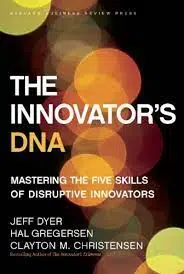The Innovator’s DNA is a book written by Jeff Dyer, Hal Gregersen, and Clayton M. Christensen. It explores the traits and behaviors that define innovative leaders, and offers practical strategies for cultivating innovation in organizations.
The authors argue that innovation is not simply a matter of talent or luck, but rather a set of skills that can be developed and nurtured. They identify five key skills that innovative leaders possess: associating, questioning, observing, networking, and experimenting. These skills, which the authors refer to as the “Innovator’s DNA,” can be learned and practiced by anyone, and are essential for driving innovation in today’s rapidly changing world.
Throughout the book, the authors provide case studies and examples of innovative leaders who have used these skills to achieve success, as well as tools and exercises for readers to develop their own innovative capabilities. The Innovator’s DNA is a valuable resource for anyone looking to foster a culture of innovation in their organization or simply to become more innovative in their personal and professional lives.
The main points of the book are:
- The Innovator’s DNA is a book that focuses on the habits, skills, and attributes of successful innovators.
- The book defines innovation as the ability to create new value through the combination of existing ideas, technologies, and resources.
- The authors identify five skills that are common to successful innovators: associating, questioning, observing, networking, and experimenting.
- Associating involves connecting seemingly unrelated ideas and concepts to create new insights and solutions.
- Questioning involves asking probing questions and challenging assumptions to uncover new opportunities and possibilities.
- Observing involves paying attention to people, markets, and trends to identify needs and opportunities for innovation.
- Networking involves building relationships and leveraging diverse networks to access new ideas and resources.
- Experimenting involves testing and prototyping ideas to validate assumptions and learn from failures.
- The authors suggest that innovation can be developed and nurtured through practice and deliberate effort.
- The book provides strategies and tools for building the innovator’s DNA, including creating an innovation-friendly culture, setting up innovation teams, and using design thinking methods.
- The book also discusses the role of leadership in fostering innovation, including the importance of setting a clear vision and creating an environment that supports risk-taking and experimentation.
- The authors suggest that innovation is not limited to a specific industry or job function, and that individuals and organizations can develop their innovator’s DNA through a combination of innate abilities and learned skills.
- The book highlights the importance of diverse perspectives and backgrounds in fostering innovation, as diverse teams are more likely to come up with novel ideas and solutions.
- The authors discuss the role of curiosity and openness in innovation, and suggest that individuals and organizations should seek out new experiences and perspectives to stimulate creative thinking.
- The book also explores the concept of “innovation ambidexterity,” or the ability to balance exploration and exploitation in order to drive both short-term results and long-term growth.
- The authors discuss the role of experimentation and prototyping in the innovation process, and suggest that organizations should adopt a “fail fast, learn fast” mindset to encourage risk-taking and learning from mistakes.
- The book also explores the role of storytelling in innovation, and suggests that innovators should use stories to communicate their ideas and persuade others to take action.
- The authors discuss the importance of building a strong personal brand as an innovator, and suggest that individuals should focus on building their reputation and credibility through their work and achievements.
- The book also explores the role of networks and partnerships in fostering innovation, and suggests that organizations should seek out and build relationships with a diverse range of partners to access new ideas and resources.
- The authors discuss the role of learning and development in fostering innovation, and suggest that organizations should invest in ongoing learning and development for their employees to help them develop the skills and abilities needed to drive innovation.
- The book also explores the role of leadership in fostering innovation, and suggests that leaders should create a culture of innovation by setting a clear vision, encouraging risk-taking, and providing support and resources for experimentation and learning.
- The authors discuss the importance of diversity and inclusion in fostering innovation, and suggest that organizations should strive to create inclusive cultures that value diverse perspectives and experiences.
- The book also explores the role of technology in fostering innovation, and suggests that organizations should embrace new technologies and platforms to access new markets and opportunities.
- The book also discusses the role of customer insights in fostering innovation, and suggests that organizations should gather and analyze customer feedback and data to identify new opportunities and solve problems.
- The authors discuss the importance of setting clear goals and metrics in fostering innovation, and suggest that organizations should establish clear objectives and metrics to measure progress and success.
- The book also explores the role of prototyping and testing in the innovation process, and suggests that organizations should use rapid prototyping and testing methods to validate assumptions and learn from failures.
- The authors discuss the importance of building an innovation-friendly culture, and suggest that organizations should create an environment that supports risk-taking, experimentation, and learning.
- The book also explores the role of leadership in fostering innovation, and suggests that leaders should model innovative behavior, provide resources and support for innovation, and create a culture that values diversity and inclusivity.
- The authors suggest that organizations should foster a culture of continuous learning and development in order to drive innovation and stay competitive in today’s fast-changing business environment.
To buy the book click here


 Click here
Click here